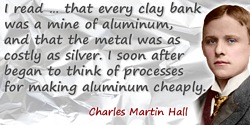 (source)
(source)
|
Charles Martin Hall
(6 Dec 1863 - 27 Dec 1914)
American chemist who invented (1886) an inexpensive electro-chemical method to extract aluminium from its ore. The process quickly enabled commercial production of this metal, at prices competitive with steel and copper. Aluminium, once a precious metal used for fine jewelry, by 1914 was down to 18 cents a pound.
|
The Properties of Aluminum.
BY CHAS. M. HALL.
[p.311] It has been stated by Prof. F. B. Crocker in an article on the “Properties and Production of Aluminum” that ninety-nine persons out of every hundred have entirely wrong ideas regarding that metal. This statement I am the more inclined to believe since reading Prof. Crocker’s own article. His statements regarding the properties of aluminum are so wide of the mark and so misleading that they ought to be corrected. My reasons for undertaking to do this are that I have given a large part of the last five years to this subject; am largely interested in the production and sale of aluminum, and am familiar with its properties as shown by the experience of the past thirty years and by what is being done with it at present.
The main idea of Prof. Crocker’s article seems to be that most of the supposed good qualities of aluminum really belong to its alloys, and are wrongly attributed to the pure metal. This may be true to a certain extent, in regard to the mechanical qualities of aluminum; but it shows a lamentable lack of information to say the same of its chemical qualities. Aluminum bronze, of the best grade, possesses 100,000 pounds tensile strength per square inch, and correspondingly high elasticity. The saying that aluminum is as strong as steel may have arisen from confounding the strength of aluminum bronze with that of pure aluminum, or it might equally have arisen from the fact that a comparison of specimens and equal weights shows aluminum to be as strong as good specimens of steel; thus the tensile strength of aluminum, 26,000 pounds, multiplied by three, for difference in specific gravity, gives 78,000 pounds, whereas the best structural steel ranges from 60,000 to 70,000 pounds per square inch.
Again, Prof. Crocker says that aluminum has only one-third the strength of wrought iron. He must show a remarkable specimen of wrought iron with a tenacity of three times 26,000 pounds per square inch to prove this assertion. The best quality of wrought iron runs from 48,000 to 50,000 pounds per square inch tenacity; so that aluminum has over one half the strength of wrought iron, section for section, and, weight for weight, is considerably stronger than wrought iron.
I am not trying to prove that aluminum is a suitable material for structural purposes, where strength is the main object. It is not, and neither is any other metal aside from iron and steel. But aluminum does compare well in strength with other metals, and for purposes where lightness, combined with moderate strength, is desired, not only will it become useful, but it is being largely used to-day.
It is doubtful if any one has been seriously misled by any confusion between the strength of aluminum and that of aluminum bronze, or if any well informed person has proposed to displace iron and steel for structural purposes with aluminum.
The most serious objections which Prof. Crocker urges against aluminum are on the score of its chemical properties, and here his information and reasoning are really unique. “Aluminum bronze,” he says, “is remarkably free from tarnishing.” “Therefore, freedom from oxidation is another property that is wrongly attributed to aluminum itself.” It is true, aluminum bronze is the best of the copper alloys for resisting oxidizing influences, but for the vast majority of uses to which metals are put, it cannot compare with pure aluminum in this respect. Aluminum here ranks with silver, and next to gold and platinum. The fallacy of Prof. Crocker’s reasoning will be apparent to any one who possesses an aluminum opera glass, or who is acquainted with the fact that next to gold aluminum is the metal most preferred by dentists for dental plates, etc., or that for sign painting and decorative purposes, aluminum leaf has the preference over silver leaf, because aluminum remains bright and silver blackens. What are the facts in regard to the corrodibility of aluminum? In the first place it is not true generally that “it is equally attacked by acid.” Of the common reagents it is dissolved only by hydrochloric acid, and by the alkaline hydrates or caustic alkalies. Sulphuric and nitric acid act upon it with extreme slowness, not dissolving it appreciably after several days’ exposure to their action. But for all ordinary uses it is no more against aluminum than against gold that it is dissolved by aqua regia or selenious acid. These strong chemical reagents, the acids and caustic alkalies, are practically unknown outside the laboratory and chemical manufactory. Because of their strong affinities, they cannot exist in our common surroundings of air, water, food, etc.
The action of the weaker organic acid, saline solutions, etc., upon aluminum is much less than any other metals except the noble metals. Alkaline carbonates do not dissolve aluminum, nor does soap, as Prof. Crocker states. Air, wet or dry, has absolutely no action on aluminum, nor has water. If it is true, as stated by Prof. Crocker, that “subjected to ordinary moist air, aluminum tarnishes and oxidizes rapidly,” I am unable to see the pertinence of his further remark that “it is not affected by sulphur or sulphureted hydrogen, which is a great advantage.” For a metal that is oxidized rapidly by moist air, there would be small use in resistance to sulphur or sulphur gases. Prof. Crocker states that “the ease of oxidizing” aluminum is “about equal to other metals, such as tin, zinc and iron.” The absurdity of this statement would be almost evident to one who had ever seen an article made of aluminum. Think of iron or tin dental plates, or of zinc leaf or sheet iron used for decorative purposes as aluminum sheet, foil, and leaf are employed. Prof. Crocker constantly asserts that “aluminum really has excellent qualities.” I am unable to see what they are on his authority.
One of my associates became interested in aluminum financially largely because of an aluminum field glass which he has possessed for twenty years. He has carried it all over the world. It has been wet with sea water and has been almost constantly exposed to “ordinary moist air” for twenty years and it has never been cleaned or polished further than wiping it with a handkerchief, and today it retains its polish and luster as perfectly as when new. The fact is that for resistance to all ordinary corroding and oxidizing influences aluminum stands next to gold and platinum and ranks equal with silver, and the difference between it and the latter metal, aside from difference in color (aluminum being of a bluish tint, which makes silver look yellow by comparison) is just this: For objects that require much handling aluminum has the disadvantage of losing a portion of its polish, probably from coming in contact with perspiration; but where it is to be exposed to the air of a house or the weather, without much handling, there is no metal which will retain its luster and polish better. Silver is blackened by exposure to the air, where aluminum is unaffected, while where aluminum is dulled and requires polishing, silver requires the same.
The foreign workers in aluminum seem to have succeeded in giving a more permanent polish and luster to aluminum under handling than we have in this country, as I judge from some aluminum articles obtained abroad. Where polish is unimportant, as for dental plates and culinary utensils, aluminum has no superior short of the noble metals. As regards aluminum cooking utensils, I am not giving this statement off-hand, but from actual experiments extending over more than a year. Cooking utensils of aluminum have been in constant use for the time stated, have been daily subjected to boiling saline solutions, washing with soap, etc., and as a result they are preferred by the users to utensils of any other metals, one reason being that they always are clean and white, while the nickel rivets used for fastening the handle to some of them became perfectly black. The same qualities of aluminum are shown by the fact that aluminum vessels have been [p.312] used for a considerable time for the manufacture of jellies, where freedom from discoloration is important, and besides are now being extensively used by one of the large canning concerns in Pittsburg, whose name and products are widely known.
The perfect antiseptic qualities of aluminum should also be noticed, which render it the best metal for culinary uses on this account, and also recommend it for surgical instruments, for which it is largely used at present.
So far as the working qualities of aluminum go, it is well known to be one of the most ductile and malleable of all metals, and therefore is very easily rolled into sheets or drawn into tubes or very finest wire. Naturally possessing such a high grade of ductility, the metal is of a tough nature, such as would not admit of easy working qualities in the lathe or in the planer; but this toughness or clinging tendency of its fibers can be readily overcome, and the metal very easily machined by simply alloying with 3 or 4 per cent. of metallic copper, which shortens the grain, but which does not interfere or change the other qualities or virtues of pure aluminum.
I am glad to see that Prof. Crocker truthfully gives aluminum credit for electrical conductivity, comparing equal weights, twice that of copper. This may be of great importance at no distant day, because, comparing equal weights, aluminum has about twelve times the conductivity of iron, and while it may not soon compete with copper for insulated wire, it is quite likely to compete with iron for telegraph wire, especially when its perfect durability on exposure to the weather is considered and as hard drawn aluminum wire can readily be made having a tensile strength of at least 60,000 pounds per square inch. There is one of the electrical properties of aluminum of which no mention is made by Prof. Crocker, but which is interesting, although it has not been much investigated nor turned to any practical use. This is its resistance to the destructive effects of the electric spark. Aluminum is superior in this respect to all other metals, and for this reason is employed by Prof. Crocker and others for electrodes in vacuum discharge tubes when electrodes of other metals are quickly torn to pieces. The question suggests itself as to its use for commutators and other electrical purposes, where such a quality is most important.
In the last of his article, Prof. Crocker makes the strange statement that “the purity of aluminum does a great deal toward improving its quality,” which indicates possibly that the aluminum upon which his article is founded is not aluminum at all, but that metal plus a considerable amount of iron, silicon, sodium or zinc. His remarks would be very pertinent in regard to such a compound. In this connection, it may be stated that it was never easier to obtain aluminum of the purest quality than at present, since the electrical process has been fully perfected.
The conclusion of Prof. Crocker is that aluminum “is not a promising material for practical use.” My belief is just the contrary, and it is founded upon a careful study of the metal and upon the practical tests made of its properties extending over several years, and made with large quantities of metal. There is no more promising material for investigation for practical use; and it has been proved that for a multitude of uses the same results in utility, beauty and durability can be obtained from aluminum, at a less cost, than from any other metal whatever.
In a paper on aluminum read last winter before the Boston Society of Arts Alfred E. Hunt, in order to give a new turn to a discussion that had fallen into a rut, ventured the statement that aluminum had been overrated, as it has by some of the unscientific papers. But now every one writing about the metal has taken the cue until aluminum has no good qualities left whatever, but is a weak, easily corrodible metal, like zinc or tin, and really “takes up more space than it is worth,” and has falsely appropriated the good qualities of its alloys. Aluminum has been overrated. There has been a kind of “glamor” associated with it, due to two facts, the first being that it is really useful, durable and beautiful, combined with the other fact, which has little to do with its commercial importance, that its ores are more abundant than of any other metal and constitute a large portion of the earth’s crust.
The world has been centuries in learning to use other metals; in learning to roll, draw, temper and polish them. Aluminum is new, but we are learning how to deal with it, how to secure the qualities of strength, hardness, ductility, luster, etc., where required, much more rapidly than has occurred in the history of the other metals.
- Science Quotes by Charles Martin Hall.
- 6 Dec - short biography, births, deaths and events on date of Hall's birth.
- Charles Martin Hall, Creator of the Aluminum Age - from The World’s Work (1914).
- Charles Hall: Invention of the Aluminum Process - Perkin Medal Award Speech (1911)
- Made of Aluminum: A Life of Charles Martin Hall, by Rosamond McPherson Young. - book suggestion.






